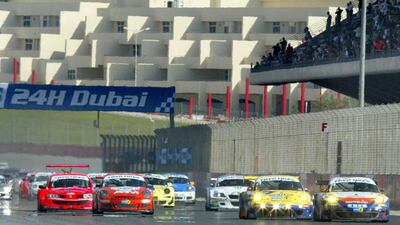It is a grainy photo for it was taken 10 years ago, but the tallest man on the podium is unmistakable.
Toto Wolff, snapped immediately after winning the inaugural Dubai 24 Hours Race on January 15, 2006, is wearing a blue race suit and black baseball cap.
He appears to smile somewhat sheepishly, his black hair creeping out from underneath his winners’ cap.
The photo was taken at Dubai Autodrome back when the racing circuit was surrounded by – in the words of one figure present – “nothing but sand and camels”.
It commemorates victory for Austria’s Duller Motorsports. The name might suggest otherwise, but they provided an absorbing race, taking pole in their BMW M3, battling a mechanical problem, dropping through the field and then determinedly fighting their way back to the front.
Such races have become routine for the Dubai 24 Hours, which celebrates its 10th anniversary this weekend.
Spotting the involvement of such famous figures as Wolff, who is executive director and the face of Formula One world champions Mercedes-GP, has become a favourite pastime of those who peruse the expanding entry list.
While the inaugural event involved 67 cars, Friday’s race features 95 teams and more than 400 drivers, including Gerard Lopez, the owner of Lotus F1, Khalid Al Qubaisi, the Emirati two-times winner, and Kevin Korjus, the young Estonian driver who tested in F1 with Lotus.
Previous fields have included Hermann Tilke, the illustrious racetrack designer, and Jan Magnussen, the former F1 driver and father of 2014 McLaren pilot Kevin.
“I never thought the interest would ever be this high,” Mohammed ben Sulayem, the president of the UAE’s Automobile and Touring Club (ATCUAE), said yesterday.
“It has evolved so much: from a privateers’ racing event 10 years ago to the showpiece that it is now, complete with full FIA-approved international endurance series status.
“It is not easy to sustain a sport, but there is an incredible effort put in to make this a success.
“People now know what they can expect from this race and that they can trust it to be a well-organised event. That is key.”
A prime example of that professionalism can be found courtesy of Hankook, the event’s newly installed official tyre supplier.
The South Korean company has brought 7,500 tyres to Dubai, including more than 2,000 wet-weather compounds that are almost certain to return to Hungary unused. In 2006, such a commitment would have been unlikely.
“We are not expecting rain and we have been told there is no rain forecast, but you must be prepared,” Manfred Sandbichler, Hankook’s director of motorsport, said yesterday as he looked up at a perfect blue sky.
Gerrie Willems, who works for Creventic, the official promoter of the six-round 24 Hours Series, visited Dubai for the first time in mid-2005 as part of a reconnaissance mission ahead of the UAE’s inaugural race six months later.
He recalled that he had preconceptions blown away by the safety he felt in the city, but said he questioned the isolated location of the 5.3-kilometre racetrack.
“My first time, I was really impressed because at that moment I only knew the Middle East from the television and, of course, it was rarely positive,” he said. “To see Dubai and to see this place and the mixture of cultures was a big eye-opener.
“I remember we had to drive for what felt like one hour to get here though. It was completely in the desert and we thought to ourselves ‘Are they stupid in Dubai? Why have they built it so far from the city?’ Now of course, we are the ones who feel a little stupid.”
With Arabian Ranches, Motorcity, Dubai Sports City, International Media Production Zone and other neighbourhoods sprouting up close by, the Autodrome is no longer so remote.
As well as placating the visiting teams, it also means the crowds at the three-day, free-entry event are growing.
Last year’s race drew a couple of thousand spectators over the weekend and this year is expected to improve again.
Although do not expect to see such fans in the sun-bleached grandstand.
The place to be is invariably behind the pit garages where motorhomes will sit alongside polyester gazebos and the smell of barbecued meat will fill the air.
There is also, inevitably, the chance to stumble across a sleeping driver with a familiar face.
After all, a lot may have changed in 10 years, but 24 hours of solid racing is still a gruelling, exhausting challenge.
gmeenaghan@thenational.ae
Follow us on Twitter @SprtNationalUAE

